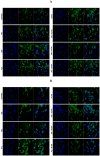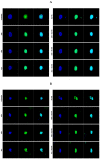The Effect of Rutin and Extracts of Uncaria guianensis (Aubl.) J. F. Gmeland on Primary Endometriotic Cells: A 2D and 3D Study
- PMID: 32183239
- PMCID: PMC7144928
- DOI: 10.3390/molecules25061325
The Effect of Rutin and Extracts of Uncaria guianensis (Aubl.) J. F. Gmeland on Primary Endometriotic Cells: A 2D and 3D Study
Abstract
There is increasing interest in the potential of natural compounds to treat diseases, such as endometriosis, a gynecological disorder that affects 10-15% of women of reproductive age, and it is related to severe pelvic pain and infertility. We have evaluated the in vitro effects of rutin and the aqueous bark, roots, and leaf extracts (ABE, ARE, and ALE, respectively) and isolated components of Uncaria guianensis on stromal cells from eutopic endometrium and lesions of patients with endometriosis. Two- and three-dimensional cultures were used to assess the cell death and production of reactive oxygen species (ROS), cytokines and growth factors of cells following exposure to these natural products. The applied treatments did not reduce cellular viability, but ROS production did increase. In addition, significant increases in the levels of interleukin (IL)-15, IL-17A, IL-4, IL-6, tumor necrosis factor-α, and vascular endothelium growth factor were observed when 2D-cells from endometrium of patients with endometriosis were treated with ABE, while exposure to ALE induced significant increases in epidermal growth factor in lesion cells.
Keywords: ROS production; anti-inflammatory; anti-oxidant; cytokines; endometriosis; growth factors; medicinal plants.
Conflict of interest statement
The authors declare no conflict of interest.
Figures







Similar articles
-
Aqueous extracts from Uncaria tomentosa (Willd. ex Schult.) DC. reduce bronchial hyperresponsiveness and inflammation in a murine model of asthma.J Ethnopharmacol. 2018 May 23;218:76-89. doi: 10.1016/j.jep.2018.02.013. Epub 2018 Feb 10. J Ethnopharmacol. 2018. PMID: 29432856
-
Synergistic effect of regulatory T cells and proinflammatory cytokines in angiogenesis in the endometriotic milieu.Hum Reprod. 2017 Jun 1;32(6):1304-1317. doi: 10.1093/humrep/dex067. Hum Reprod. 2017. PMID: 28383711
-
Anti-inflammatory and antitumoural effects of Uncaria guianensis bark.J Ethnopharmacol. 2013 Dec 12;150(3):1154-62. doi: 10.1016/j.jep.2013.10.055. Epub 2013 Nov 7. J Ethnopharmacol. 2013. PMID: 24212077
-
17β-estradiol and lipopolysaccharide additively promote pelvic inflammation and growth of endometriosis.Reprod Sci. 2015 May;22(5):585-94. doi: 10.1177/1933719114556487. Epub 2014 Oct 29. Reprod Sci. 2015. PMID: 25355803 Free PMC article.
-
Urocortin 2 and urocortin 3 in endometriosis: evidence for a possible role in inflammatory response.Mol Hum Reprod. 2011 Sep;17(9):587-93. doi: 10.1093/molehr/gar020. Epub 2011 Mar 30. Mol Hum Reprod. 2011. PMID: 21454316
Cited by
-
Endometriosis and Phytoestrogens: Friends or Foes? A Systematic Review.Nutrients. 2021 Jul 24;13(8):2532. doi: 10.3390/nu13082532. Nutrients. 2021. PMID: 34444692 Free PMC article.
References
MeSH terms
Substances
Grants and funding
LinkOut - more resources
Full Text Sources
Medical

